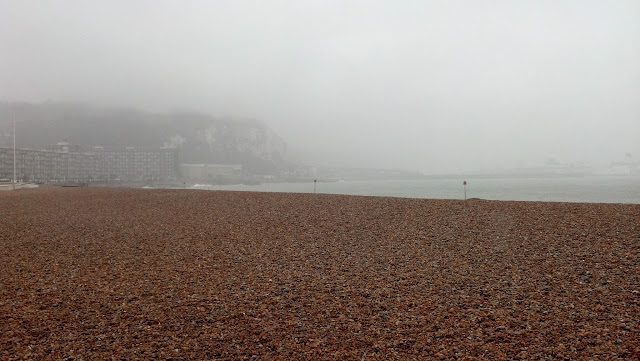We spent a day touring Southeast England. One of the places we went was Leeds Castle.
Leeds Castle was built in 1119, and was used as a residence for royalty for hundreds of years. They used it as kind of a hunting lodge. Anyone have a hunting lodge like this?
Black swans are the symbol of Leeds Castle, and many swim in the lake there.
We went on a day with miserable weather, so our pictures are somewhat grey, but here's a shot of it (from the Wikipedia Commons) that was taken when the sky was blue:
Next we went to Dover for lunch, and to see the famed white cliffs.
I mentioned that we had terrible weather. It hadn't improved by the time we got to Dover, and the white cliffs were only just visible through the downpour.
Can you see?
Wikipedia Commons to the rescue again:
Our next stop was Canterbury Cathedral. Canterbury Cathedral in Canterbury, Kent, is one of the oldest and most famous Christian structures in England and forms part of a World Heritage Site. It is the cathedral of the Archbishop of Canterbury, leader of the Church of England and symbolic leader of the worldwide Anglican Communion. Its formal title is the Cathedral and Metropolitical Church of Christ at Canterbury.
Founded in 597, the cathedral was completely rebuilt 1070-77. The east end was greatly enlarged at the beginning of the twelfth century, and largely rebuilt in the Gothic style following a fire in 1174. The Norman nave and transepts survived until the late fourteenth century, when they were demolished to make way for the present structures.
Not a great photo of me, but it was raining, windy and cold after all.
I am always amazed at how these massive cathedrals could have been built without modern tools and machinery. These ceilings are incredible.
A pivotal moment in the history of Canterbury Cathedral was the murder of Thomas Becket in the north-west transept (also known as the Martydom) on Tuesday 29 December 1170 by knights of King Henry II. The king had frequent conflicts with the strong-willed Becket and is said to have exclaimed in frustration, "Who will rid me of this turbulent priest?" The knights took it literally and murdered Becket in his own cathedral. Becket was the second of four Archbishops of Canterbury who were murdered, but the only one to have been murdered in the cathedral itself.
King Henry the VIII began the Reformation in the 16th century, during which, many images and art in churches were destroyed.
I love to look at the ceilings in these cathedrals as well as the floors. Both were fantastic here.
I love how this photo gives you a sense of the scale of the inside of the cathedral - this is looking down one of the halls that run on either side of the cathedral.
So much history to be seen - really just fantastic to this American's eyes.

































really fantastic architecture--and to think of all of our modern UGLY buildings we throw up with so much mechanical assistance by comparison!
ReplyDeleteHello I am so delighted I located your blog, I really located you by mistake, while I was watching on google for something else, Anyways I am here now and could just like to say thank for a tremendous post and a all round entertaining website. Please do keep up the great work. Demolition
ReplyDelete